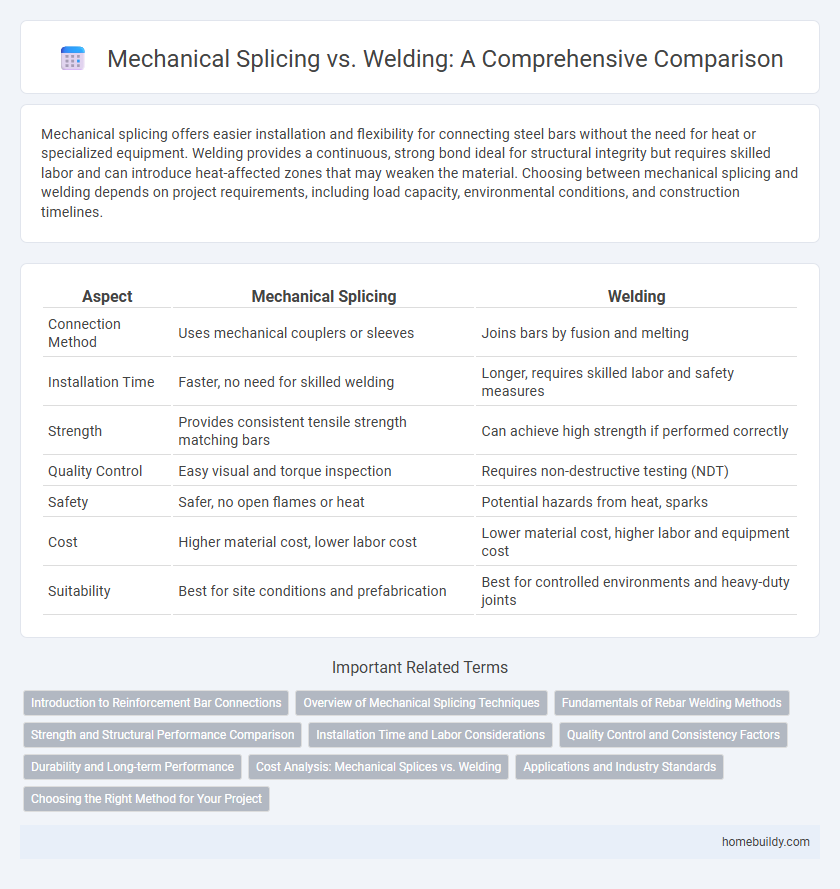Mechanical splicing offers easier installation and flexibility for connecting steel bars without the need for heat or specialized equipment. Welding provides a continuous, strong bond ideal for structural integrity but requires skilled labor and can introduce heat-affected zones that may weaken the material. Choosing between mechanical splicing and welding depends on project requirements, including load capacity, environmental conditions, and construction timelines.
Table of Comparison
| Aspect | Mechanical Splicing | Welding |
|---|---|---|
| Connection Method | Uses mechanical couplers or sleeves | Joins bars by fusion and melting |
| Installation Time | Faster, no need for skilled welding | Longer, requires skilled labor and safety measures |
| Strength | Provides consistent tensile strength matching bars | Can achieve high strength if performed correctly |
| Quality Control | Easy visual and torque inspection | Requires non-destructive testing (NDT) |
| Safety | Safer, no open flames or heat | Potential hazards from heat, sparks |
| Cost | Higher material cost, lower labor cost | Lower material cost, higher labor and equipment cost |
| Suitability | Best for site conditions and prefabrication | Best for controlled environments and heavy-duty joints |
Introduction to Reinforcement Bar Connections
Mechanical splicing and welding are two primary methods for connecting reinforcement bars in concrete structures to ensure structural integrity and load transfer. Mechanical splicing involves using mechanical couplers that provide a reliable and standardized connection without altering the bar's properties, while welding fuses bars together to create a monolithic joint but may affect the steel's mechanical characteristics. Choosing the appropriate reinforcement bar connection depends on factors such as project specifications, construction speed, labor skill, and the required strength of the splice.
Overview of Mechanical Splicing Techniques
Mechanical splicing techniques for reinforcement bars involve connectors that join bars without altering their original properties, ensuring structural integrity and ease of installation. Common methods include threaded couplers, swaged couplers, and grouted sleeves, each providing reliable load transfer through mechanical interlock or adhesion. These techniques reduce labor time and improve quality control compared to welding, which can introduce heat-affected zones and potential weak points.
Fundamentals of Rebar Welding Methods
Rebar welding methods primarily involve electric arc welding, resistance welding, and flash butt welding, each ensuring strong, durable joints by metallurgically fusing reinforcement bars. Electric arc welding uses intense heat generated by electrical arcs to melt the rebar ends, facilitating a solid bond upon cooling, while resistance welding applies pressure and electrical current to create a weld through resistance heat. Understanding these fundamental techniques is crucial for selecting appropriate splicing methods that maintain structural integrity and comply with industry standards in reinforced concrete construction.
Strength and Structural Performance Comparison
Mechanical splicing of reinforcement bars provides consistent tensile strength comparable to welded joints while minimizing heat-affected zones that can weaken the steel. Studies demonstrate that mechanical splices maintain the structural integrity of concrete elements under cyclic loading, offering enhanced fatigue resistance compared to traditional welding methods. The controlled fabrication process of mechanical splices ensures uniform performance, reducing the risk of brittle fractures and improving overall durability in reinforced concrete structures.
Installation Time and Labor Considerations
Mechanical splicing of reinforcement bars significantly reduces installation time by eliminating the need for extensive on-site welding and cooling periods. This method also lowers labor costs since it requires less specialized workforce and minimal inspection compared to welding processes. Welding, while providing strong joints, demands skilled labor and longer curing times, which can delay project timelines and increase overall labor expenses.
Quality Control and Consistency Factors
Mechanical splicing of reinforcement bars offers superior quality control through standardized manufacturing processes that ensure consistent performance and reduced defects compared to welding. Welding introduces variability due to operator skill and heat-affected zones, which can compromise bar strength and lead to inconsistencies in structural integrity. Rigorous inspection protocols and non-destructive testing methods applied to mechanical splices enhance reliability and uniformity in reinforced concrete construction.
Durability and Long-term Performance
Mechanical splicing of reinforcement bars provides enhanced durability by minimizing risks of heat-affected zones and material weakening that often occur in welding. Long-term performance favors mechanical splicing as it maintains consistent tensile strength and corrosion resistance, essential for structural integrity over time. Welding can lead to brittleness and potential fatigue cracks, compromising reinforcement bars in enduring load conditions.
Cost Analysis: Mechanical Splices vs. Welding
Mechanical splicing of reinforcement bars typically reduces labor costs and on-site construction time compared to welding, which requires skilled labor and controlled environments. Welding involves higher energy consumption and additional safety measures, increasing overall project expenses. Cost analysis often favors mechanical splices for large-scale projects due to their efficiency and lower risk of defects.
Applications and Industry Standards
Mechanical splicing of reinforcement bars is widely preferred in construction projects requiring rapid assembly and high structural integrity, conforming to standards such as ASTM A1034 and BS 8666. Welding reinforcement bars, governed by codes like AWS D1.4 and Eurocode 2, is typically applied in precast concrete elements and situations demanding continuous load transfer with minimal sectional loss. Industry standards emphasize mechanical splicing for seismic zones due to superior ductility, while welding remains restricted to controlled environments to avoid metallurgical defects.
Choosing the Right Method for Your Project
Mechanical splicing of reinforcement bars offers greater flexibility, easier field installation, and consistent mechanical performance compared to welding, which requires skilled labor and can introduce heat-affected zones weakening the steel. Project specifications, rebar size, and site conditions heavily influence the choice between mechanical splicing and welding, with mechanical couplers often preferred for high-strength and seismic applications. Evaluating factors like structural requirements, cost, and inspection protocols ensures selecting the optimal splicing method to maintain the integrity and safety of the reinforced concrete structure.
Mechanical Splicing vs Welding Infographic

 homebuildy.com
homebuildy.com